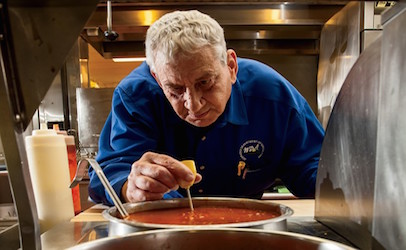Restaurant food in the Hawkeye State might be getting more risky just as it’s time once again for those quadrennial events they call the Iowa caucuses. Restaurant inspections are a state and local responsibility that has forced the cash-strapped Iowa Department of Inspections and Appeals (IDIA) to carry a larger share of the burden. In just the past year, IDIA has seen the number of counties where the state must do restaurant inspections increase to 52 of Iowa’s 99 counties. IDIA was responsible for eight fewer counties (44) just a year ago.  The other 47 counties are inspected by counties or municipalities that do the work, in part, under contracts with IDIA. Iowa restaurants are supposed to be inspected twice a year, but since 2011, IDIA has tried to make money for both its own inspections and those that are contracted cover by going to a risk-based system. New administrative rules took effect Jan. 1, 2014, that assigned a risk factor to various restaurant types. It means a Starbucks or a Jimmy John’s rated low-risk might experience a restaurant inspection only once every two years, while a very high-risk facility such as a sushi bar might be inspected once every six months. Food license fees don’t cover enough of the costs of inspections, and cities and counties that take on the task are typically using local tax dollars to pay for 30 to 40 percent of the food program costs, according to an Iowa official familiar with the program. He says the risk-based approach helps take some of the pressure off for the contract-inspected counties, adding, “But it’s not good for those citizens living in areas inspected by IDIA.” And now it appears another legislative session is going to slip away without Iowa doing anything about the problem, which just continues to restrict restaurant inspections more and more as time passes. Senate File 265, introduced on Feb. 18 by state Sen. Bill Dotzler, was to be the vehicle for fixing Iowa’s restaurant inspection problem, but it’s gone nowhere and is seen as dead by everybody, including its sponsor. The Waterloo Democrat says he’s still pushing for a funding boost for restaurant inspections. However, that may also be difficult since Iowa Governor Terry Branstad reportedly does not allow agencies to lobby or advocate for sums not in the executive-proposed budget. So if the Iowa Legislature is going to pump up the funding, the fight will have to be led by public health organizations. The number of Iowa restaurants and grocery stores inspected once every two years rather than twice a year, as in the past, has Sandy Heinen concerned. “That concerns me not only as an inspector but also as someone who dines out,” the Black Hawk County environmental health officer told Iowa media. Black Hawk County is one of the local governments which uses local taxes to make up for the stagnant state funding. While prospects for SF 265 are dim, nobody is claiming credit for its defeat. The Iowa Lodging Association, the Iowa Restaurant Association, Petroleum Marketers and Convenience Stores of Iowa, Iowa Retail Association and Iowa Association of Business and Industry all claimed to be “undecided” on Dotzler’s bill.
The other 47 counties are inspected by counties or municipalities that do the work, in part, under contracts with IDIA. Iowa restaurants are supposed to be inspected twice a year, but since 2011, IDIA has tried to make money for both its own inspections and those that are contracted cover by going to a risk-based system. New administrative rules took effect Jan. 1, 2014, that assigned a risk factor to various restaurant types. It means a Starbucks or a Jimmy John’s rated low-risk might experience a restaurant inspection only once every two years, while a very high-risk facility such as a sushi bar might be inspected once every six months. Food license fees don’t cover enough of the costs of inspections, and cities and counties that take on the task are typically using local tax dollars to pay for 30 to 40 percent of the food program costs, according to an Iowa official familiar with the program. He says the risk-based approach helps take some of the pressure off for the contract-inspected counties, adding, “But it’s not good for those citizens living in areas inspected by IDIA.” And now it appears another legislative session is going to slip away without Iowa doing anything about the problem, which just continues to restrict restaurant inspections more and more as time passes. Senate File 265, introduced on Feb. 18 by state Sen. Bill Dotzler, was to be the vehicle for fixing Iowa’s restaurant inspection problem, but it’s gone nowhere and is seen as dead by everybody, including its sponsor. The Waterloo Democrat says he’s still pushing for a funding boost for restaurant inspections. However, that may also be difficult since Iowa Governor Terry Branstad reportedly does not allow agencies to lobby or advocate for sums not in the executive-proposed budget. So if the Iowa Legislature is going to pump up the funding, the fight will have to be led by public health organizations. The number of Iowa restaurants and grocery stores inspected once every two years rather than twice a year, as in the past, has Sandy Heinen concerned. “That concerns me not only as an inspector but also as someone who dines out,” the Black Hawk County environmental health officer told Iowa media. Black Hawk County is one of the local governments which uses local taxes to make up for the stagnant state funding. While prospects for SF 265 are dim, nobody is claiming credit for its defeat. The Iowa Lodging Association, the Iowa Restaurant Association, Petroleum Marketers and Convenience Stores of Iowa, Iowa Retail Association and Iowa Association of Business and Industry all claimed to be “undecided” on Dotzler’s bill.
Sponsored by Marler Clark
